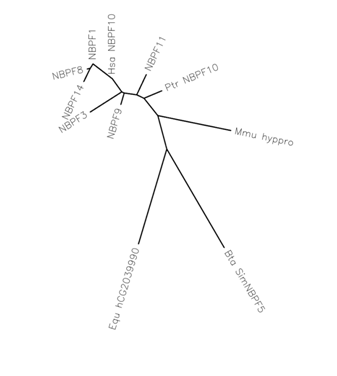NBPF10 on:
[Wikipedia]
[Google]
[Amazon]
Neuroblastoma breakpoint family member 10 is a


protein
Proteins are large biomolecules and macromolecules that comprise one or more long chains of amino acid residues. Proteins perform a vast array of functions within organisms, including catalysing metabolic reactions, DNA replication, respo ...
that in ''Homo sapiens
Humans (''Homo sapiens'') are the most abundant and widespread species of primate, characterized by bipedalism and exceptional cognitive skills due to a large and complex brain. This has enabled the development of advanced tools, culture, ...
'' is encoded by the ''NBPF10'' gene
In biology, the word gene (from , ; "...Wilhelm Johannsen coined the word gene to describe the Mendelian units of heredity..." meaning ''generation'' or ''birth'' or ''gender'') can have several different meanings. The Mendelian gene is a ba ...
.
The full gene is 75,313 bp, with the major isoform of mRNA
In molecular biology, messenger ribonucleic acid (mRNA) is a single-stranded molecule of RNA that corresponds to the genetic sequence of a gene, and is read by a ribosome in the process of Protein biosynthesis, synthesizing a protein.
mRNA is ...
being 10,697 bp long. The gene is located at 1q21.1. NBPF contains what is known as the DUF1220
The Olduvai domain, known until 2018 as DUF1220 (domain of unknown function 1220) and the NBPF repeat, is a protein domain that shows a striking human lineage-specific (HLS) increase in copy number and appears to be involved in human brain evolu ...
repeats. The highly conserved, repeated region is believed to be originated from MGC8902. The NBPF family has been linked to primate evolution. It is assumed to be related to the 1q21.1 deletion syndrome
1q21.1 deletion syndrome is a rare aberration of chromosome 1. A human cell has one pair of identical chromosomes on chromosome 1. With the 1q21.1 deletion syndrome, one chromosome of the pair is not complete, because a part of the sequence of the ...
and 1q21.1 duplication syndrome
1q21.1 duplication syndrome or 1q21.1 (recurrent) microduplication is a rare aberration of chromosome 1.
In a common situation a human cell has one pair of identical chromosomes on chromosome 1. With the 1q21.1 duplication syndrome one chromosome ...
.
Homology
Paralogs of NBPF10 includes other NBPF family members. Orthologs of NBPF10 are found in other primates; distant orthologs are found in bovine, equine, and canine
Functional role
Although NBPF10's function is unknown, there is reason to believe that NBPF10 is an importantbiomarker
In biomedical contexts, a biomarker, or biological marker, is a measurable indicator of some biological state or condition. Biomarkers are often measured and evaluated using blood, urine, or soft tissues to examine normal biological processes, ...
for the Odontoblast
In vertebrates, an odontoblast is a cell of neural crest origin that is part of the outer surface of the dental pulp, and whose biological function is dentinogenesis, which is the formation of dentin, the substance beneath the tooth enamel on the ...
Phenotype
In genetics, the phenotype () is the set of observable characteristics or traits of an organism. The term covers the organism's morphology or physical form and structure, its developmental processes, its biochemical and physiological proper ...
Gene Neighborhood
NOTCH2NL
Notch homolog 2 N-terminal-like is a family of proteins that in humans consists of 3 proteins (NOTCH2NLA, NOTCH2NLB, and NOTCH2NLC) and is encoded by NOTCH2NL gene. It appears to play a key role in the development of the prefrontal cortex, a par ...
, SEC22B, HFE2, TXNIP are close neighbors of NBPF10. All of these neighboring genes are well studied in their own right.
Post-translational modification
NBPF10 has extremely lowthreonine
Threonine (symbol Thr or T) is an amino acid that is used in the biosynthesis of proteins. It contains an α-amino group (which is in the protonated −NH form under biological conditions), a carboxyl group (which is in the deprotonated −COOâ ...
content which may make the protein less susceptible to post-translational modification
Post-translational modification (PTM) is the covalent and generally enzymatic modification of proteins following protein biosynthesis. This process occurs in the endoplasmic reticulum and the golgi apparatus. Proteins are synthesized by ribosome ...
.
References
Human proteins {{gene-1-stub